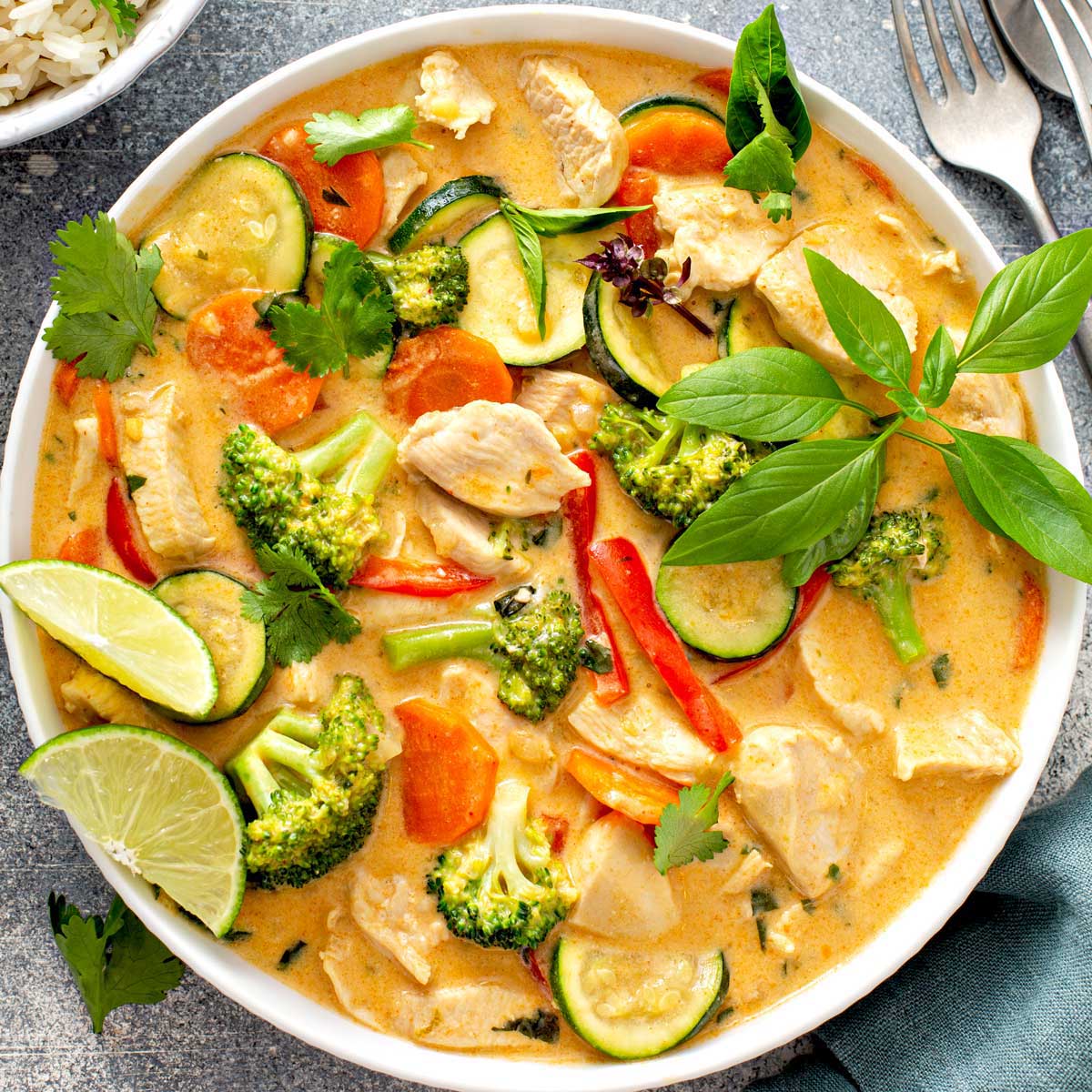Craving the vibrant explosion of flavors found in authentic Thai curries but burdened by allergies? Fear not! This guide unveils the secrets to crafting delicious, allergen-free Thai curries that are bursting with taste and brimming with aromatic spices. We’ll explore common allergens in traditional recipes, offering clever substitutions that maintain the integrity of each curry’s unique profile. Learn to navigate ingredient sourcing, preparation techniques to avoid cross-contamination, and visually stunning presentation ideas to elevate your culinary creations. Prepare to embark on a flavorful journey that respects dietary needs without compromising on the rich tapestry of Thai cuisine.
From mastering the art of substituting fish sauce with umami-rich alternatives to understanding the nuances of different spice combinations, this guide provides a comprehensive toolkit for creating unforgettable allergen-free Thai red, green, and yellow curries. Each recipe is meticulously detailed, guiding you through every step with vibrant descriptions of textures and colors, ensuring a successful and delicious outcome. Discover how to enhance the depth of flavor without relying on common allergens, using clever techniques and ingredient choices that will leave you amazed.
Flavor Enhancement Techniques for Allergen-Free Thai Curries

Creating vibrant and flavorful Thai curries without common allergens like soy sauce and fish sauce requires a strategic approach to flavor building. The absence of these umami powerhouses necessitates a thoughtful layering of tastes and textures to achieve a depth that rivals traditional recipes. This involves harnessing the power of a diverse range of herbs, spices, and other flavor-enhancing ingredients.
The key to success lies in understanding how different flavor profiles interact and complement each other. Instead of relying on a single dominant flavor, we can build complexity through a harmonious blend of sweet, sour, salty, bitter, and umami notes, achieved through careful ingredient selection and cooking techniques.
Umami Enhancement Without Fish Sauce or Soy Sauce
Building umami without relying on fish sauce or soy sauce involves leveraging other ingredients known for their savory depth. Mushrooms, particularly shiitake and oyster mushrooms, are excellent sources of glutamates, the compounds responsible for umami. Other ingredients like tomatoes, sun-dried tomatoes, and aged cheese (like Parmesan or nutritional yeast for vegan options) contribute significantly to the overall savory profile. The careful caramelization of vegetables also enhances their inherent umami notes.
The following recipe demonstrates a practical approach to creating a deeply flavorful, allergen-free red curry:
Allergen-Free Red Curry Recipe
This recipe showcases how to build layers of flavor using a variety of ingredients to achieve a rich and complex taste without relying on common allergens. The use of mushrooms and caramelized vegetables contributes significantly to the umami profile.
Ingredients:
1 tbsp coconut oil
1 large onion, finely chopped
2 cloves garlic, minced
1 inch ginger, minced
8 oz shiitake mushrooms, sliced
1 red bell pepper, sliced
1 (14 oz) can full-fat coconut milk
2 tbsp red curry paste (ensure allergen-free)
1 tbsp brown sugar
1 lime, juiced
1/2 cup vegetable broth
1 cup bamboo shoots, sliced
1 cup broccoli florets
1/2 cup chopped cilantro
Salt and pepper to taste
Instructions:
1. Heat coconut oil in a large pot or wok over medium heat. Add onion and cook until softened, about 5 minutes. Add garlic and ginger and cook for another minute until fragrant.
2. Add shiitake mushrooms and red bell pepper. Cook until slightly softened, about 5 minutes. Allow the vegetables to caramelize slightly for enhanced flavor.
3. Stir in red curry paste and cook for 1 minute, stirring constantly, to toast the spices.
4. Pour in coconut milk, brown sugar, and lime juice. Bring to a simmer and cook for 10 minutes, stirring occasionally.
5. Add vegetable broth, bamboo shoots, and broccoli. Simmer for another 5-7 minutes, or until vegetables are tender-crisp.
6. Season with salt and pepper to taste. Garnish with fresh cilantro before serving.
Note: The caramelization of the vegetables in step 2 is crucial for enhancing their umami flavor. Take your time with this step, allowing the vegetables to brown slightly before adding the curry paste.
Ingredient Sourcing and Preparation for Allergen-Free Cooking
Creating authentically flavorful allergen-free Thai curries hinges on selecting the highest quality ingredients and meticulously handling them to prevent cross-contamination. This process demands careful attention to detail, from the initial sourcing to the final storage. The reward, however, is a vibrant and safe culinary experience.
Ingredient sourcing for allergen-free cooking requires a discerning eye and a commitment to transparency. Prioritizing reputable suppliers who understand and adhere to strict allergen control protocols is paramount. This minimizes the risk of accidental contamination and ensures the integrity of your ingredients.
Sourcing High-Quality, Allergen-Free Ingredients
Finding reliable sources for allergen-free ingredients is crucial. Look for producers who clearly label their products, specifying the absence of common allergens like peanuts, tree nuts, soy, dairy, wheat, eggs, and shellfish. Consider specialty stores catering to individuals with dietary restrictions, as these often carry a wider selection of certified allergen-free products. Farmers’ markets can also be a valuable resource, allowing you to directly inquire about growing practices and potential cross-contamination risks. Always verify the absence of allergens by carefully checking labels and, if necessary, contacting the manufacturer directly. For example, coconut milk should be sourced from a producer explicitly stating that their product is processed in a facility free of common allergens. Similarly, lemongrass and galangal, often found in Thai markets, should be sourced from reputable suppliers who can assure the absence of cross-contamination from other products during processing or packaging.
Preparation Methods to Prevent Allergen Cross-Contamination
Preventing cross-contamination is equally important as ingredient selection. Designate separate cutting boards, knives, and utensils specifically for allergen-free cooking. Thoroughly wash and sanitize all equipment before and after use, paying particular attention to removing any lingering traces of potential allergens. Use separate containers for storing raw and cooked ingredients to avoid accidental mixing. When preparing ingredients like herbs and spices, consider purchasing pre-packaged, allergen-free versions to minimize the risk of cross-contamination during handling. Imagine a vibrant scene in a Thai kitchen: one section meticulously dedicated to allergen-free preparation, with gleaming stainless steel surfaces and clearly labeled containers, distinctly separated from the area used for other dishes. This visual representation highlights the importance of dedicated workspace for allergen-free cooking.
Proper Storage of Allergen-Free Ingredients
Proper storage extends the freshness and prevents contamination of allergen-free ingredients. Store ingredients in airtight containers to maintain their quality and prevent moisture absorption, which can lead to spoilage. Label all containers clearly, indicating the contents and the date of purchase or preparation. This simple practice helps in managing inventory and ensures that older ingredients are used first. Refrigerate perishable items promptly and freeze ingredients that you won’t use immediately to extend their shelf life. For instance, fresh herbs like cilantro and basil, crucial components of many Thai curries, should be stored in airtight containers in the refrigerator to maintain their vibrant color and fresh aroma. Similarly, pre-made pastes or spice blends, if not commercially allergen-free, should be stored separately from other ingredients and labeled meticulously.
Serving Suggestions and Presentation of Allergen-Free Thai Curries
Elevating the dining experience extends beyond the careful crafting of allergen-free Thai curries; it encompasses thoughtful pairings and visually stunning presentations. The right accompaniments can enhance the curry’s flavors, while an artful presentation transforms a simple meal into a feast for the eyes.
The following sections detail suitable side dishes, presentation techniques, and garnishes that will elevate your allergen-free Thai curry creations.
Suitable Side Dishes and Accompaniments
Careful consideration of side dishes complements the rich flavors of Thai curries while ensuring the meal remains allergen-free. A balanced selection of textures and tastes provides a complete and satisfying culinary experience.
- Jasmine Rice: Its delicate fragrance and fluffy texture provide a neutral canvas for the bold curry flavors. Imagine a mound of pearly white rice, steaming gently, forming a perfect base for a vibrant spoonful of curry.
- Coconut Rice: Infusing the rice with coconut milk adds a layer of sweetness and richness that harmonizes beautifully with many Thai curry variations. Picture the rice grains glistening with a subtle sheen of coconut oil, hinting at the creamy indulgence to come.
- Steamed Vegetables: A medley of vibrant green beans, brightly colored carrots, and tender broccoli florets offer a refreshing contrast to the richness of the curry. Visualize the contrasting colors and textures – the deep green of the beans against the orange of the carrots, all steaming gently, adding a pop of freshness to the plate.
- Allergen-Free Noodles: Rice noodles or gluten-free alternatives provide a different textural experience, allowing for a more substantial meal. Imagine a nest of delicate, pale rice noodles nestled beside a pool of fragrant curry, their soft texture a counterpoint to the curry’s intensity.
Visually Appealing Presentation Methods
Presentation is key to enhancing the dining experience. Careful plating techniques can transform a simple dish into a culinary masterpiece, captivating the diner’s senses before the first bite.
- Layered Presentation: Arrange the rice or noodles as a base, followed by a generous portion of curry, and finally, the garnishes. This creates visual depth and showcases the components of the dish. Imagine a cascading effect, with the colors and textures of each element distinct yet harmoniously arranged.
- Bowl Presentation: Serving the curry in a shallow, wide bowl allows for a more rustic and inviting presentation. The curry’s vibrant colors are showcased, creating a visually appealing centerpiece. Picture a rustic, earthenware bowl overflowing with a richly colored curry, the aromas wafting enticingly.
- Individual Portions: For a more elegant presentation, serve individual portions in smaller bowls or on individual plates. This is ideal for formal settings or when catering to a crowd. Envision a series of elegantly arranged plates, each a miniature work of art, showcasing the curry’s beauty.
Attractive Garnishes to Complement Thai Curries
Garnishes are the finishing touch, adding visual appeal and enhancing the flavors of the curry. A carefully chosen garnish can elevate the entire culinary experience.
- Fresh Cilantro: Its vibrant green hue and fresh, slightly citrusy flavor provide a beautiful contrast to the curry’s richness. Imagine bright green sprigs of cilantro scattered artfully across the curry, their delicate leaves adding a pop of color and freshness.
- Lime Wedges: A bright yellow-green lime wedge not only adds a burst of acidity but also provides a striking visual contrast. Picture a juicy lime wedge, its vibrant color a striking contrast to the warm tones of the curry, promising a zesty burst of flavor.
- Chopped Roasted Peanuts (ensure allergen-free): If peanuts are not an allergen concern, their earthy flavor and crunchy texture add another dimension to the dish. Imagine a scattering of golden-brown, roasted peanuts, their earthy aroma and satisfying crunch adding textural contrast to the smooth curry.
- Red Chili Flakes: A sprinkle of bright red chili flakes adds a touch of visual spice and hints at the curry’s potential heat. Picture tiny, fiery red specks scattered across the surface of the curry, a visual promise of the heat that awaits.
Creating allergen-free Thai curries doesn’t mean sacrificing the bold, aromatic flavors that define this beloved cuisine. By understanding common allergens and their suitable replacements, and by embracing creative flavor enhancement techniques, you can confidently craft stunning curries that are both delicious and safe. This guide empowers you to explore the world of Thai cooking with confidence, allowing you to share the vibrant taste of these dishes with a wider audience, all while celebrating the richness and diversity of Thai culinary traditions. So, gather your ingredients, embrace the adventure, and prepare to tantalize your taste buds with allergen-free Thai curries that are truly exceptional.
FAQ Summary
Can I freeze allergen-free Thai curries?
Yes, allergen-free Thai curries freeze well. Allow them to cool completely before storing in airtight containers for up to 3 months.
What are some good vegan substitutes for coconut milk?
While coconut milk is traditional, you can experiment with full-fat cashew cream or silken tofu blended with vegetable broth for a creamy texture.
How long can I store leftover allergen-free curry?
Store leftovers in an airtight container in the refrigerator for up to 3-4 days.
Are all Thai curry pastes allergen-free?
No, many commercially available Thai curry pastes contain common allergens like peanuts, fish sauce, or shellfish. Always check labels carefully.


